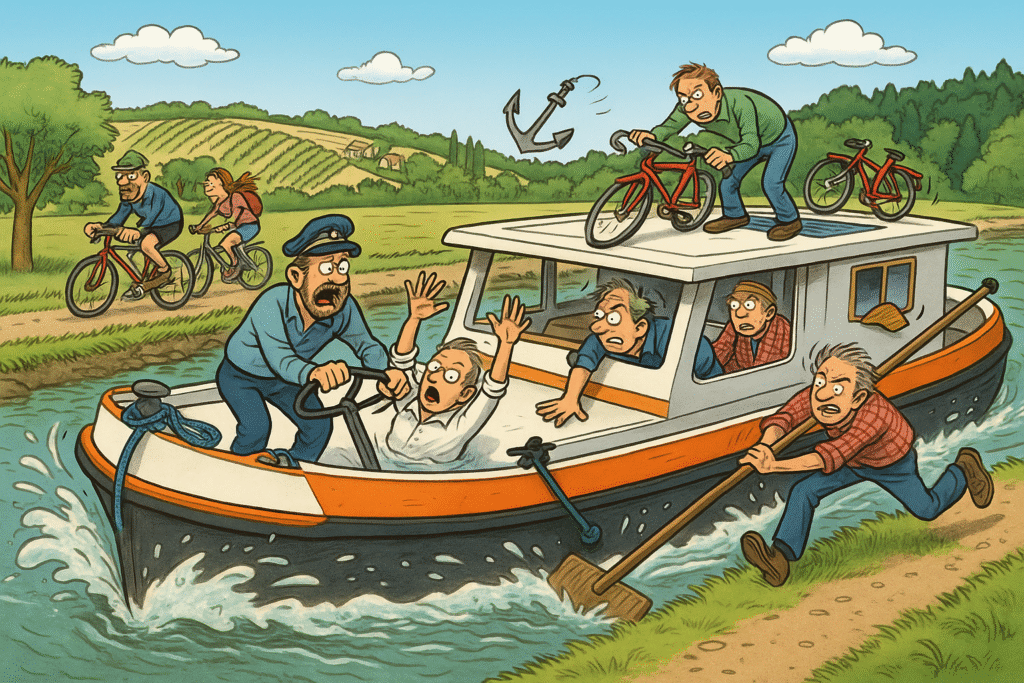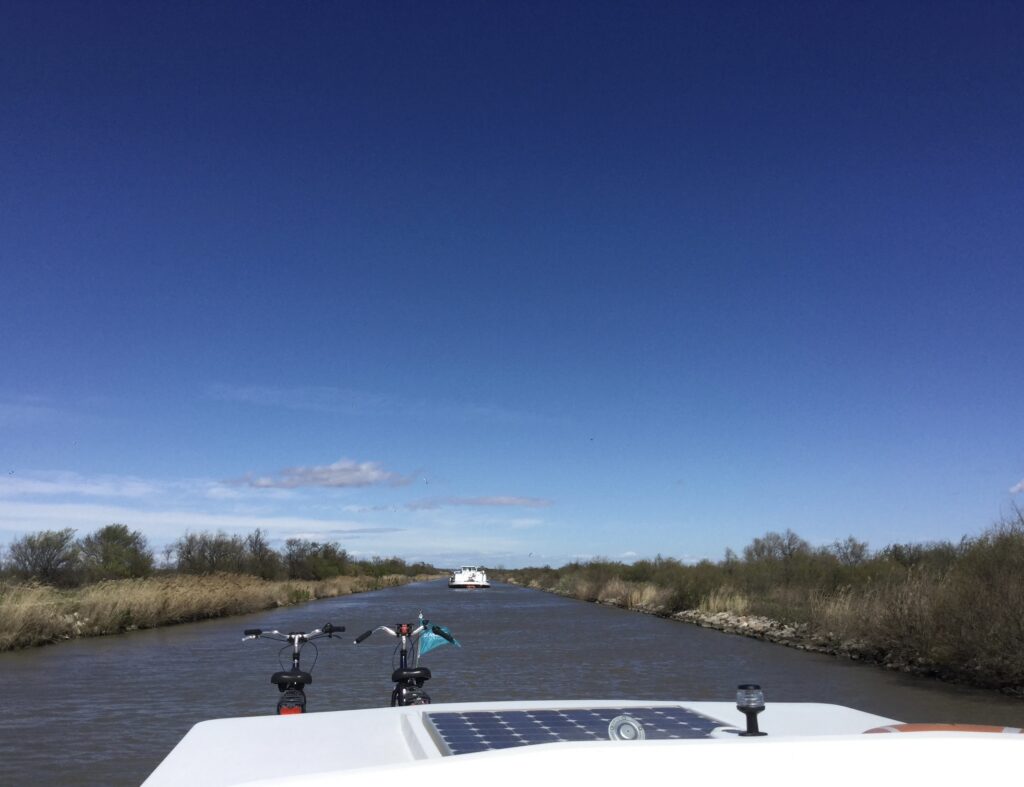
ChatGPT:
Title:
“From Steering Wheel to Tillering Fiasco: A Guide to the Glorious Misery of Driving a Barge in France”
Or: How to Go from Linear Logic to Nonlinear Regret in 68 Locks or Less
INTRODUCTION: LINEAR EXPECTATIONS, NONLINEAR HUMILIATION
Let’s start where your journey began—in a car. A beautiful, obedient machine that does exactly what you ask of it (except parallel parking). You turn the wheel a little, the car turns a little. You turn it more, the car turns more. That’s a linear system—predictable, friendly, basically the golden retriever of physics.
And then one day you think, “What if I drove a barge in France?”
This is where the wheels fall off—metaphorically, of course, since barges don’t have wheels, just your shattered expectations drifting downstream.
Driving a barge is not like driving a car. It’s not like driving anything. It’s like writing a strongly worded letter to the water and hoping it eventually obeys. This, dear reader, is your introduction to nonlinear systems, canal-based suffering, and the extremely avoidable chaos of self-driving holidays in French inland waterways.
CARS: SIMPLE MACHINES FOR SIMPLE JOYS
Before we throw you in the canal of consequences, let’s appreciate the simplicity of your car:
- You steer left → it goes left.
- You stop accelerating → it slows down.
- You hit the brakes → it stops (shockingly useful).
- You arrive on time, in control, with dry shoes.
All this is possible because the mechanics of driving a car are linear:
- Inputs and outputs scale predictably.
- You control the direction directly.
- There’s friction with the road.
- Newton’s laws behave themselves.
Driving a car makes you feel competent.
Driving a barge makes you question your life choices.
BARGES: GIANT, FLOATING MATH JOKES
Now enter the barge—a vehicle that does not obey logic, gravity, or your shouted instructions.
Let’s clarify something: you don’t “drive” a barge. You negotiate with it. Slowly. Desperately.
Here’s why barges are textbook nonlinear systems:
1.
Delayed Response
You steer—and nothing happens. Then, after a suspenseful pause, it turns way too much. Then you overcorrect. Then that overcorrects. You’re now spinning. Congratulations: your barge is doing interpretive dance.
2.
Momentum from Hell
Your barge is 50 feet long, made of steel, and weighs more than your self-esteem. Once it’s moving, it does not want to stop. No brakes. You slow down with reverse thrust and prayers.
3.
Wind is Your Enemy
A mild breeze will push your barge diagonally into the bank like a bored toddler swatting a toy. Any side wind turns your entire vessel into a sluggish kite.
4.
Rudder-based steering
You don’t steer the barge itself. You redirect water, and the water slowly nudges the stern, which slowly swings the front, which slowly turns the barge. All of this happens just slowly enough for you to think nothing’s happening—until it’s too late.
THE UNFORESEEN HAZARDS OF THE FRENCH CANAL SYSTEM
You thought, “Ah, France. Wine. Cheese. Floating gently past castles.”
And you were wrong.
⚠️
Locks. So Many Locks.
Some canals—like the infamous Canal de Bourgogne—have 60+ locks per week. Each one is a hydraulic mood swing that requires:
- Tying ropes in a panic
- Shoving the barge off walls with a boat hook
- Screaming “IS IT OPEN YET?”
- Possibly launching a crew member into the water (accidentally)
⚠️
Wind from the Mediterranean
On canals like the Rhône à Sète, sea winds slam into your barge like an air-powered slapstick routine. You’ll try to steer forward and end up on the wrong bank, angled like you’re ashamed of your own trajectory.
⚠️
Overconfident Crew
There’s always a retired navy captain who says, “We can go faster.”
There’s always someone who thinks “mooring next to a lock during lunch” is safe.
There’s always a tech guy who can code in 14 languages but uses a mooring pole like a catapult.
HOW TO ACTUALLY STEER A BARGE (WITHOUT BECOMING A TRAGIC MEME)
📍 Before You Start:
- Assign roles. Someone steers. Someone mans the ropes. Someone points at ducks.
- Check wind conditions. If trees are moving, your barge will too.
- Test your tiller. Left is right. Right is left. This is not a metaphor.
📘 THE BARGE STEERING MANUAL (with Sarcasm-Free Translation)
STEP 1:
Throttle is your lifeline
- Always steer with some forward momentum. No speed = no rudder control.
- Reverse = your brake. Use it early and gently.
STEP 2:
To turn left, push the tiller right
- This moves the back of the barge right, swinging the front left.
- WAIT. Let the barge respond. Do not wiggle it like a Wii controller.
STEP 3:
Wind management
- Point the bow slightly into the wind to counter sideways drift.
- If you drift too much, stop everything. Reposition slowly.
- Side wind? Expect to hit the bank at least once. Just pretend it was on purpose.
STEP 4:
Approaching a lock
- Slow down way earlier than feels necessary.
- Come in at an angle—line up as you enter.
- Throw mooring lines to your rope guy (hopefully not the one who fell in last time).
- Reverse gently to halt inside the lock.
STEP 5:
Mooring like a civilized person
- Use two mooring lines minimum.
- Hammer poles fully into the bank (not just half-hearted taps).
- Never moor next to an active lock. Just don’t. Trust us.
STEP 6:
Turning Around (God Help You)
- Use reverse and full rudder in open canal sections only.
- Accept that it will take three tries and half your pride.
PRO TIPS (FROM PEOPLE WHO SURVIVED)
- Bring gloves. Rope burn is not romantic.
- Assign designated sober crew during lunch stops.
- Carry a boat hook—for pushing off the bank and fishing out crew members who “slipped.”
- Respect the 8 km/h limit. It’s not a suggestion. It’s a physical law of barge equilibrium.
- Don’t fight the barge. Think like a barge. Slow. Heavy. Majestic. Confused.
FINAL THOUGHTS: YOU’LL SURVIVE (PROBABLY)
You’re not just on vacation. You’re taking part in a centuries-old dance of water, physics, and human misjudgment.
Will you drift?
Yes.
Will you spin?
Almost definitely.
Will you moor perfectly?
No, but you’ll lie about it later.
And one day, after the blisters have faded and the wine has worn off, you’ll find yourself at a dinner party, swirling your glass, and someone will say,
“Didn’t you do a barge trip in France?”
And you’ll smile and reply:
“Ah yes. We lost an anchor. Nearly overtook a nun’s barge. Pushed a CEO into the canal. It was wonderful.”
And that, my friend, is barge life.
Suggested reading:
- “Zen and the Art of Not Overcorrecting”
- “Advanced Rope Tossing for Business Executives”
- “How Not to Blame the Wind (Even Though It Was Definitely the Wind)”


